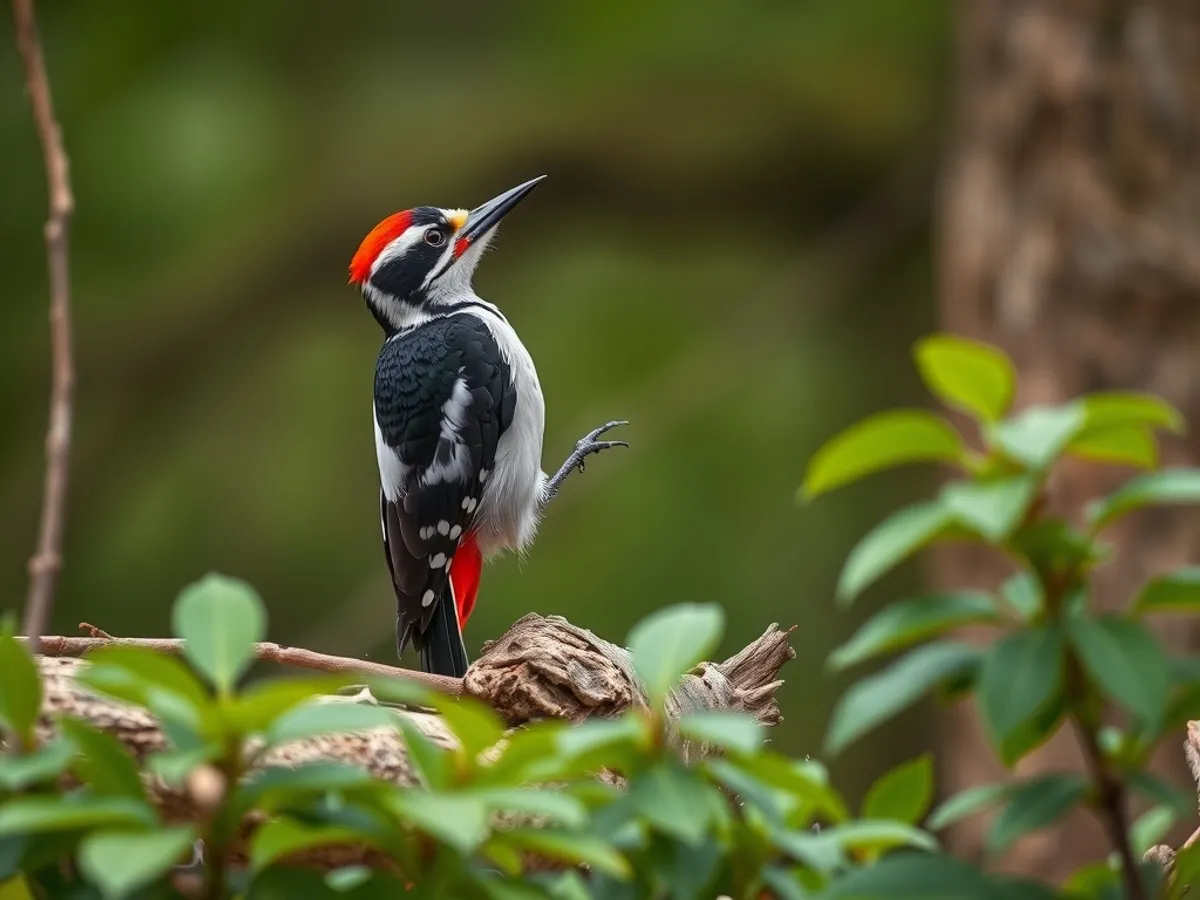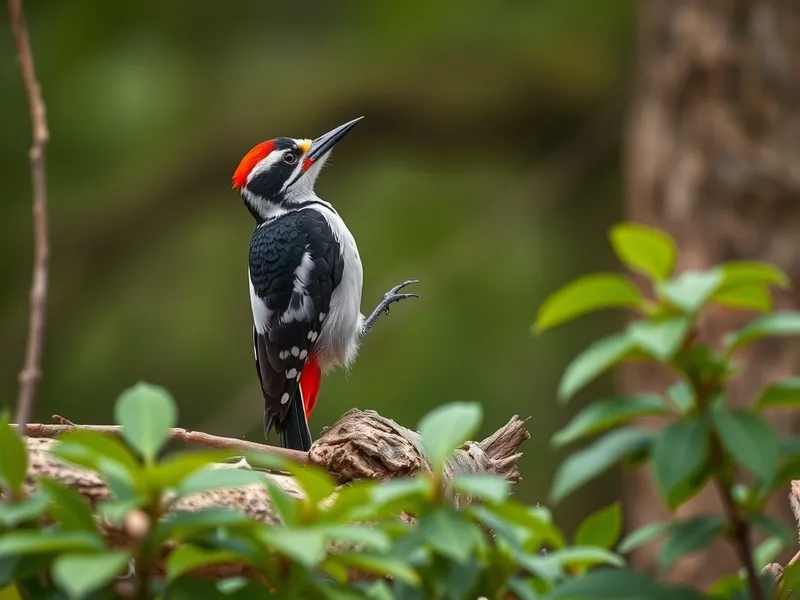
Great Spotted Woodpecker
Dendrocopos major

Meet the Great Spotted Woodpecker
The Great Spotted Woodpecker is a medium-sized woodpecker native to Europe and parts of Asia, easily recognized by its striking black-and-white plumage and vivid red undertail. Males also sport a distinctive red patch on the nape, while juveniles have a red crown. This agile bird is known for its loud drumming on tree trunks, a behavior used to establish territory and attract mates. Adaptable and resourceful, it thrives in woodlands, parks, and even gardens, feeding on insects, seeds, and nuts. The Great Spotted Woodpecker plays an important ecological role by controlling insect populations and creating nesting holes used by other species.
Classification
Bird
Habitat
Temperate and boreal forests, woodlands, parks, and gardens
Diet
Omnivore
Lifespan
5-11 years
Conservation
Least Concern
Weight
70-98 g
📖Fascinating Facts
Powerful Drummers
Great Spotted Woodpeckers drum on trees at up to 20 times per second, using their strong beaks and reinforced skulls to avoid brain injury.
Shared Parenting
Both parents share the duties of incubating eggs and feeding the young, reflecting a high level of parental cooperation.
Nuts and Anvils
They use a technique called 'anvilling'—wedging nuts into tree bark to break them open with their beak.
📋Detailed Description
The Great Spotted Woodpecker (Dendrocopos major) is a robust, medium-sized woodpecker, measuring 23–26 cm in length with a wingspan of 38–44 cm and weighing between 70–98 grams. Its plumage is strikingly pied, with glossy black upperparts, white shoulder patches, and white underparts, while the lower belly and vent area are bright crimson. Males are distinguished by a red patch on the nape, absent in females, and juveniles display a red crown. The bill is strong, chisel-shaped, and adapted for excavating wood, while the zygodactyl feet (two toes forward, two backward) and stiff tail feathers provide stability during vertical climbing. The species is highly vocal, producing sharp 'kick' calls and a characteristic drumming sound by rapidly striking wood, which is used for communication and territory defense. Great Spotted Woodpeckers are solitary for most of the year, except during the breeding season. They are highly adaptable, occupying a range of wooded habitats from mature forests to urban parks and gardens. Their diet is omnivorous, including insects, larvae, seeds, nuts, and occasionally eggs or nestlings of other birds. The species is a keystone cavity-nester, excavating nest holes that later provide shelter for other birds and small mammals. Their population is stable and widespread across the Palearctic, with some northern populations exhibiting partial migratory behavior.
💡 Did you know?
The Great Spotted Woodpecker can drum up to 10-16 times per second, producing a sound that can be heard over long distances.
🔬Research & Sources
Wikipedia Summary
The great spotted woodpecker is a medium-sized woodpecker with pied black and white plumage and a red patch on the lower belly. Males and young birds also have red markings on the neck or head. This species is found across the Palearctic including parts of North Africa. Across most of its range it is resident, but in the north some will migrate if the conifer cone crop fails. Some individuals have a tendency to wander, leading to the recolonisation of Ireland in the first decade of the 21st century and to vagrancy to North America. Great spotted woodpeckers chisel into trees to find food or excavate nest holes, and also drum for contact and territorial advertisement; like other woodpeckers, they have anatomical adaptations to manage the physical stresses from the hammering action. This species is similar to the Syrian woodpecker.
Last Modified: 4/30/2025
🎭Behavior & Social Structure
Great Spotted Woodpeckers are diurnal and primarily solitary, except during the breeding season or when juveniles accompany parents. They exhibit strong territoriality, with males and females defending feeding and nesting territories through drumming and vocalizations. Foraging involves methodical climbing along trunks and branches, probing bark crevices for insects and larvae, and using their powerful bills to chisel into wood. In autumn and winter, they shift to seeds and nuts, often wedging large food items into crevices (an 'anvil') to hammer them open. They are known for their intelligence and problem-solving abilities, occasionally raiding nest boxes for eggs or chicks. Daily routines include periods of active foraging interspersed with rest and preening. Outside the breeding season, individuals may roam widely in search of food, especially in years of poor cone crops.
👶Reproduction & Life Cycle
Breeding occurs from April to June, with pairs forming monogamous bonds for the season. Courtship involves mutual drumming, chasing, and display flights. Both sexes participate in excavating a new nest hole each year, typically 3–10 meters above ground in a dead or decaying tree. The female lays 4–7 glossy white eggs, incubated by both parents for 10–13 days. Chicks are altricial and remain in the nest for 20–24 days, during which both parents feed them a diet rich in insects. Fledglings are cared for by parents for several weeks post-fledging. The species is single-brooded, though replacement clutches may occur if the first is lost.
🛡️Adaptations & Survival
The Great Spotted Woodpecker exhibits several specialized adaptations: its skull has spongy bone and a reinforced structure to absorb shock from pecking; the tongue is long, barbed, and sticky, capable of extending up to 40 mm beyond the bill to extract insects; the hyoid apparatus wraps around the skull, providing tongue support and shock absorption. Zygodactyl feet and stiff tail feathers enable vertical climbing and bracing against tree trunks. The bill is self-sharpening and grows continuously to compensate for wear. Behavioral adaptations include food caching and use of anvils to process hard seeds and nuts. Their cryptic coloration provides camouflage against tree bark.
📚Research Sources
🎨Cultural Significance
The Great Spotted Woodpecker features in European folklore as a symbol of persistence and industriousness, owing to its tireless drumming. In some cultures, woodpeckers are associated with forest health and are considered indicators of biodiversity. The species is a favorite among birdwatchers and has been depicted in art, literature, and children’s stories. It also plays an educational role in promoting woodland conservation and awareness of deadwood’s ecological importance.
🔬Recent Research & Discoveries
Recent research has focused on the biomechanics of woodpecker drumming, revealing adaptations that protect the brain from impact injuries. Genetic studies have clarified relationships within the Dendrocopos genus and documented hybridization with the Syrian Woodpecker (D. syriacus) in contact zones. Long-term monitoring in Europe has tracked population trends and responses to habitat changes, while studies on recolonization in Ireland have provided insights into dispersal and habitat connectivity. Ongoing research explores the species’ role in forest ecosystems as a keystone cavity-nester and its interactions with other woodland fauna.
🎥Wildlife Videos

Things you need to know about GREAT SPOTTED WOODPECKERS!
From what they eat to where they nest, how long they live for and what noises they make. This video will give you lots of ...
A Shot Of Wildlife

Great Spotted Woodpecker - Mini Documentary - Buntspecht
Hey guys and girls, this is a small documentary about the Great Spotted Woodpecker (Dendrocopos major, Buntspecht) The video ...
Wildlife Documentary

Great Spotted Woodpecker | Short Documentary | Olympus
Measuring up to 9 inches and weighting 85 grams, the Great Spotted Woodpecker has a very distinctive bouncing flight and ...
Samuel Rusu

Woodpecker Birds | Free Documentary Nature
Welcome To My FREE DOCUMENTARY NATURE Channel and Thanks For Watching My Videos Videos 🖇️ Links ...
Wildlife

The Enigmatic Woodpecker: Nature’s Skilled Carpenter | Wildlife Documentary | Fusion Documentary
Explore the world of the enigmatic woodpecker in this wildlife documentary. Witness nature's skilled carpenter in action!
Fusion Documentary

Wildlife in Cornwall - Hoopoe, Spoonbill, Great Spotted Woodpecker, Redpoll and More
Wildlife in Cornwall - Hoopoe, Spoonbill, Great Spotted Woodpecker, Redpoll and More Filmed and Edited by Paul Dinning ...
Paul Dinning
🌍Habitat Information
The Great Spotted Woodpecker typically inhabits Temperate and boreal forests, woodlands, parks, and gardens environments. Great Spotted Woodpeckers have adapted to their environments with specialized features and behaviors.
Primary Habitat:
Temperate and boreal forests, woodlands, parks, and gardens
More detailed habitat information will be available soon.
🛡️Conservation Status
The Great Spotted Woodpecker is currently classified as Least Concern. Conservation efforts are crucial for preserving this species for future generations.
Common Threats:
- 🏠Habitat loss and fragmentation
- 🌡️Climate change impacts
- 🎯Hunting and poaching
- 🏭Human-wildlife conflict
⚠️Threats & Conservation Challenges
Currently, the species faces few major threats and is classified as Least Concern by the IUCN. However, local declines may occur due to loss of mature woodland, removal of deadwood (critical for nesting), and intensive forestry practices. In some regions, competition for nest sites with invasive species or increased predation by mammals and birds of prey can be a challenge. Climate change may alter food availability and habitat suitability in the long term. Despite these, the species has shown resilience and adaptability, with populations stable or increasing in much of its range, including successful recolonization of Ireland in the early 21st century.
🔬Scientific Classification
Scientific Name
Dendrocopos major
Classification Hierarchy
🔍 About Taxonomic Classification
Taxonomic classification is a hierarchical system used by scientists to classify and organize living organisms based on shared characteristics and evolutionary relationships.
The system moves from broad categories (Kingdom) to increasingly specific ones, with each animal's scientific name typically consisting of its Genus and species.
📝Community Notes
Share your observations and insights about the Great Spotted Woodpecker with our community of wildlife enthusiasts.
Join Our Community
Sign in to share your observations and connect with fellow wildlife enthusiasts.
Sign In to ContributeNo community notes yet
Be the first to share your observations about the Great Spotted Woodpecker!
Explore Great Spotted Woodpecker
Select a tab above to learn more about this amazing animal.
📸Photo Gallery
No photos available for this animal yet.
🌟Discover More Wildlife
Continue your journey of discovery with more fascinating animals from our database
